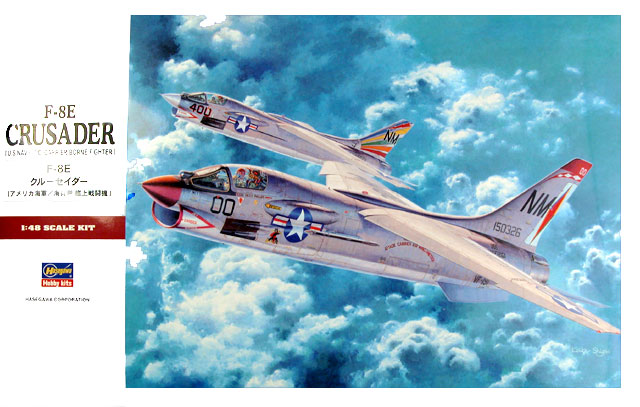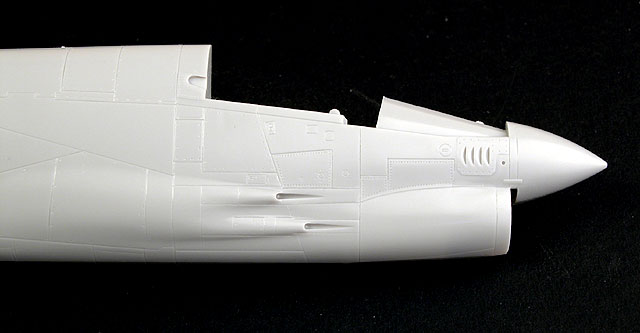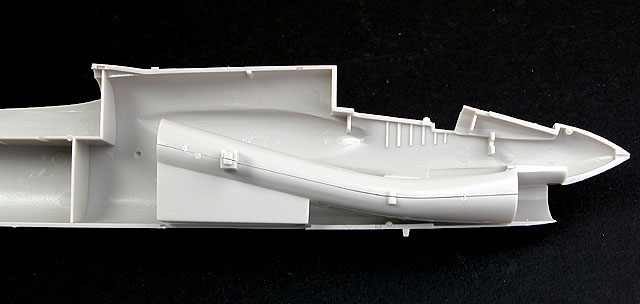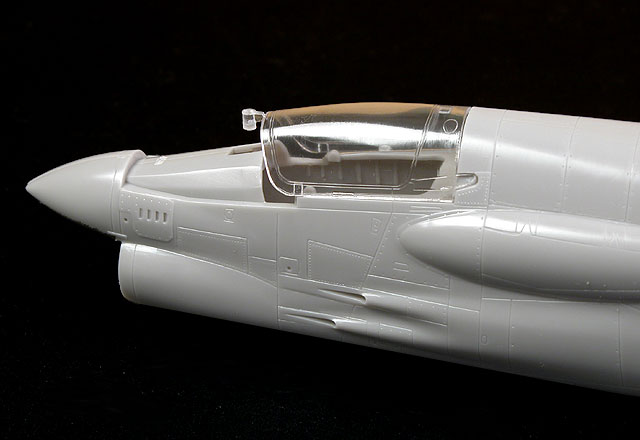|
F-8E Crusader
QuickLook Preview

Hasegawa
S
u m m a r y
|
| Catalogue Number: |
07225 |
| Scale: |
1/48 |
| Contents and Media: |
105 parts in light grey plastic; 14
in clear; 12 poly caps; decal sheet with markings for four aircraft. |
| Price: |
3200¥ (or
USD$36.96 from Squadron.com) |
| Review Type: |
QuickLook Preview |
| Advantages: |
Much wanted subject; excellent
surface detail; good engineering; encouraging fit of main assemblies
(based on dry fitting); includes separate flaps and slats; positionable
wing (ie, up or down); includes Zuni rockets and launchers plus other
rails and racks; movable horizontal; tailplanes; two-piece canopy;
markings for four colourful aircraft. |
| Disadvantages: |
Many and prominent ejector pin
holes/marks; canopy can only be displayed closed without modification;
poly-cap secured wing looks like it might be insecure; some softer detail
on bottom of the fuselage. |
| Recommendation: |
Recommended |
Previewed
by
Brett Green

Hasegawa's 1/48
scale F-8E Crusader will be available online from Squadron.com
Hasegawa continues its commitment to post-war US naval
aviation with their brand-new 1/48 scale F-8E Crusader.
Opening the box this morning prompted a feeling of deja vu. The large sprues, the pale grey plastic and the parts breakdown
betrayed a strong family resemblance to earlier Hasegawa releases such as
their F-4 Phantoms, F-14 Tomcats and F-18 Hornets. The Crusader is clearly
part of an evolutionary process.
105 parts are supplied in light grey plastic, 14 parts in
clear and an additional 3 sprues of 4 poly caps also come with the kit. The
large sprues are packed in too few bags, resulting in scuffing on the surface
of major parts including the fuselage.
Hasegawa has provided plenty of useful choices for the
modeller including optional position wing (up or down), separate flaps and
slats, Zuni rockets and mounts for additional ordnance (but the ordnance
itself is not supplied).
Detail in the cockpit and landing gear is good, but there
seems to be plenty of potential for superdetailing in the wheel wells and in
the front office. Hasegawa has left the choice of whether to use small, clear
detail parts to the modeller. Fuselage and wing mounted navigation lights are
moulded solid on the grey plastic, but clear parts are supplied if the
modeller wants to drill out, or carve off, the solid plastic lights.
Surface detail is generally excellent. Vents, hatches and
panel lines are crisp and fine. Some of the detail is a little soft on the
bottom of the fuselage, but even in this area the features are acceptable.

There are a very large number of ejector pin marks, both
raised and recessed, in visible areas of many of the smaller parts. I do
understand that ejector pin marks are a necessary evil of the moulding
process, but the sheer number of marks on this kit suggests imperfect
planning.
Engineering of the kit is very good. I wanted to check out the
parts breakdown and fit of the kit in a number of key areas, so I snipped the
main parts from the sprues and dry-fitted them.
My initial impressions are very favourable. Without glue and
even without tape, the fuselage halves match up without steps or gaps. The
wing sits nicely over the fuselage, lining up well with the top of the
fuselage at both the front and the rear (the image below shows the front of
the wing slightly raised).

The intake ducting was another potentially tricky area. In
fact, Hasegawa has done extremely well here. The ducting is positively located
with two square lugs inside the fuselage. The lip of the duct fits flush
against the back of the intake. Only the most fastidious modeller (and one
with a lot of time on his hands) will bother with filler here.

While we are still on the subject of the nose, there is a
mould break visible on the inside of the nose. This suggests the possibility
of earlier variants and photo reconnaissance versions being released by
Hasegawa in the future.
The wing is secured with three poly caps in the top wing well
of the fuselage. Similarly, the horizontal tailplanes are movable due to their
connection via poly caps. I am a little concerned that this method of
construction may not be secure enough for these large parts. If this turns out
the be the case, it will be relatively simple to underpin these areas with
stronger glue and/or reinforcement rods.
Although a two-part canopy is supplied, it can only be
displayed closed. This is due to the deeply recessed locating positions in the
fuselage. The canopy hinges are moulded as part of the clear part. These
hinges click securely into the locating recesses in the fuselage, but they do
not permit the canopy to be displayed in any position other than closed. It
might have been nicer for Hasegawa to supply two inserts for the fuselage area
immediately behind the canopy - one with the recesses in the closed position,
and one positioning the canopy open.
I have not decided the best solution to fix this problem; but
at a minimum it will involve thinning the hinges and the rear top lip of the
canopy, filling and sanding the locating recesses in the fuselage and maybe
more work. Let's hope that a vacform canopy is on its way!

I was looking forward to Hasegawa's 1/48 scale F-8E Crusader
and I was not disappointed after examining its contents today.
This kit seems to share many of the hallmarks of its ancestors
(Hasegawa's 1/48 scale F-4s, F-14s etc), but with a simpler parts breakdown.
If you like Hasegawa's earlier US Navy jet releases, you will like this kit
too.
Recommended.
Text and Images Copyright © 2003 by
Brett Green
Page Created 06 February, 2003
Last updated 15 August, 2003
Back to HyperScale Main Page
Back to Reviews Page
|
Home | What's
New | Features
| Gallery |
Reviews | Reference
| Forum
| Search